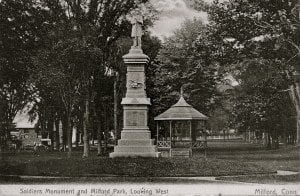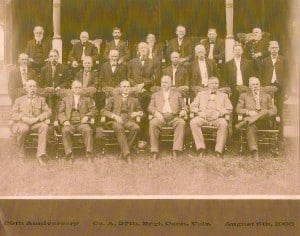
 On August 31, 1888, 23 years after the end of the Civil War, a 30-foot granite monument was erected on the Milford Green. The edifice, known as the Soldiers’ and Sailors’ Monument, features a single Union soldier atop a two-stage pedestal and was made possible by contributions from the local Grand Army of the Republic (GAR) post, a fraternal organization composed of Civil War veterans.
On August 31, 1888, 23 years after the end of the Civil War, a 30-foot granite monument was erected on the Milford Green. The edifice, known as the Soldiers’ and Sailors’ Monument, features a single Union soldier atop a two-stage pedestal and was made possible by contributions from the local Grand Army of the Republic (GAR) post, a fraternal organization composed of Civil War veterans.
The George Van Horn Post #39 GAR and private donors raised about $3,000 for the monument. (George Van Horn was a Milford resident who enlisted on October 20, 1861 in the 1st Connecticut Light Battery, was promoted to corporal in 1863, and discharged November 2, 1864.) The monument’s lettering records just four of the battles in which Milford men fought, and in some cases died, to protect their town and country: Port Hudson, Fort Fisher, Appomattox, Gettysburg.
The monument was erected 25-years after the Battle of Gettysburg which took place July 1-3, 1863 and halted the advance of General Robert E. Lee’s Confederate troops into the North. It is regarded as a turning point in the Civil War.
During the Civil War, approximately 50,000 men from Connecticut served in the Union Army; 245 of them came from Milford. Many of the Connecticut men who fought in the Battle of Gettysburg also fought in Virginia campaigns that included Fredericksburg and Chancellorsville.
Cash bounties of $100 were offered by the City of Milford to stimulate recruitment during the early days of Civil War. At the time there were two rates of pay for Milford’s boys in blue: Unmarried, enlisted men were paid $8 a month to serve, while married men were paid $12. In addition, officers were empowered to draw money from the town treasury to uniform men in their company.
Connecticut paid a high price in casualties at Gettysburg. In addition to gunshot, cannon shot, and bayonet deaths, soldiers died from disease and exposure. A total of 68 men from Connecticut were killed on the Gettysburg battlefield, 285 were wounded, and 91 were captured. Two men from Milford, Corporal Charles Cornwall and Private William O. Scott, were among the fatalities. Two Milford men survived. All four soldiers had been assigned to the 27th Connecticut Infantry Regiment.
The mortally wounded Milford men were killed on the second day of the battle, July 2, 1863, in an area known as the Wheat Field, near the base of a small rocky hill called Little Round Top. At 4:30 pm on July 2nd, the golden wheat field was transformed into a whirlpool of death as, over a period of 2½ hours, the ground changed hands 6 times.
Corporal Cornwall was 21-years old when he was killed. He was born in Milford on October 14, 1842 and was raised in our town. A headstone in Milford Cemetery marks his final resting place. Private Scott was 20-years old when was died. He was born in Watertown, and prior to enlisting he worked as a laborer on a farm belonging to Hugh Carley of Orange. He gave Milford as his town of residence at the time he enlisted.
In addition to Cornwall and Scott, Milford residents John F. Sanford, a clerk, 20-years old, and Almond E. Clark, a local farmer, 22-years old, fought and survived the Gettysburg bloodshed. Clark held the rank of Private, while Sanford held the rank of Sargent.
2018 marks the 130th year since the placement of the monument. The dedication in 1888 was an impressive celebration. Governor Phineas C. Lounsbury came to town. Cannon fire and a 13-gun salute announced his arrival. Church bells rang, factory whistles blew, flags were raised, and a parade took place. Many who had served in the war participated in the festivities, and no doubt all bowed their heads in remembrance of those men who had made the ultimate sacrifice at places like Chancellorsville, Port Hudson, and Gettysburg.
This granite reminder still towers over the Green, as a prominent reminder of a different time.
—Lou Emery
The base of Milford’s Civil War memorial reads:
A Tribute To the Bravery of the Men
Who Risked Their Lives That
The Nation Might Live
1861 – 1865





